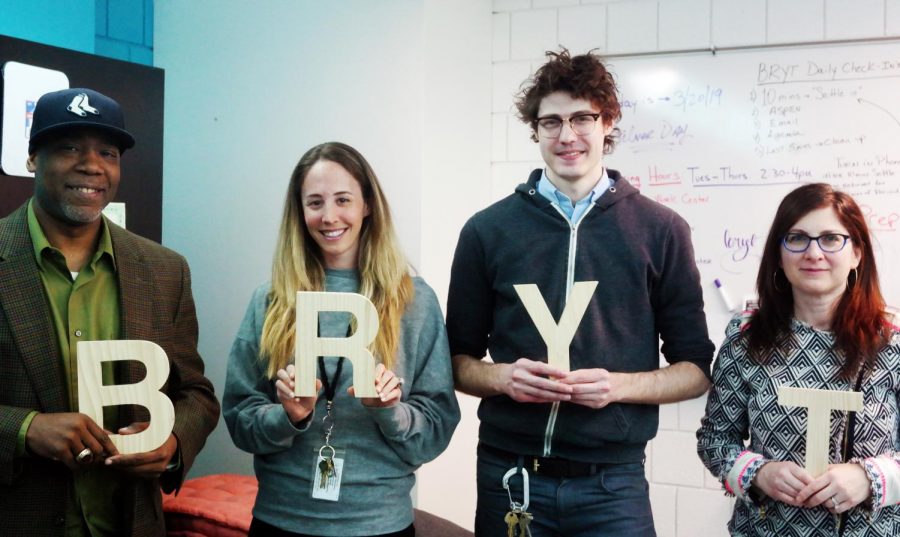Behind the Scenes: BRYT Program
The BRYT Program has expanded from seven to 30 students since it started in March of 2017.
March 29, 2019
Tucked away on the second floor of the Arts Building is a zen, blue room, home to CRLS’ Bridge for Resilient Youth in Transition (BRYT) program. Many CRLS students pass by the “welcome” sign on the door daily, yet have no idea about the program that operates inside.
BRYT is a short-term, general education program that supports students who have missed school due to mental health or other medical struggles. The goal of the program is to help reintegrate students back into school by offering clinical and academic support to assist the transition. At the moment, as CRLS BRYT social worker Ashley Sitkin explained, students in this specific situation are the only people who get accepted into the program, but with more funding she hopes they will eventually be able to open BRYT to more students.
Junior James Hopper found BRYT after an especially challenging freshman year. Hopper began missing school due to anxiety and depression, and so during his sophomore year, his guidance counselors connected him with BRYT: “I started out the year and it was going really, really well … everyone [at BRYT] just wants you to do your best, and it sounds cliche, but it’s like family over there,” he explained.
The program started as a pilot program at CRLS in March of 2017, serving seven students. Since then, the program has worked with 30 students to date. “However,” Ms. Sitkin explained, “we need more funding in order to grow the program.”
Hopper spoke to the importance of BRYT being accessible to all students explaining, “In my opinion, so many people could benefit from being [in] BRYT … because I feel like, as youths and as teenagers, we deal with a lot, but we don’t talk about what we’re going through and BRYT just does that. I can’t explain it in a simpler way—they just have your best interests.”
Students enrolled in the program come for a block every day for about twelve weeks (although it may vary for each student) to receive the program’s clinical and academic supports.
Nkrumah Jones, the program’s academic coordinator, explained his role as “an academic liaison between the teachers and the students, and in some cases the families as well.” He continued, saying, “I’m the person that goes to your teachers, lets them know and acknowledge you were out.” Mr. Jones talks with the student’s teachers to identify benchmark assignments, which demonstrate “competency, if not mastery, in a specific course,” and coordinates work for students when they return to classes.
For clinical support, Ms. Sitkin first meets with new students, their families or caretakers, and any outside providers they may be working with “to better understand what kind of emotional struggles either are getting in the way of them reaching their full academic potential or emotional struggles that could come up as they reintegrate into school.” After the initial meetings, Ms. Sitkin will continue to meet with students as needed. She also explained that some students feel “really overwhelmed with being back in school, and they’ll want to come to the BRYT room to check in and get support, and so that’s something that I can do.”
Mr. Jones explained that community members’ knowledge of the program varies. There is a BRYT advisory group, “which does have some teachers and administrators from the high school along with some parents.” However, Mr. Jones continued, “A lot of teachers are just finding out about it and are being introduced to us because we have a student of theirs.” Hopper agreed, “It’s known, but not as well as it should be.”
Senior Charlotte Keats got to know the program last year when she tutored for the structured academics program connected to BRYT. “I really love tutoring,” she said. “At first, I found it hard, but then I connected with the students and the teachers and found that it is really such a safe and caring environment.”
Hopper currently attends the extension school where he “just started to flourish … with all the coping skills, all the stuff that BRYT had taught me I started applying that to my everyday life and it started to work out really well. My depression and anxiety started going down and I was attending school a lot more regularly.”
Hopper explained that, thanks to BRYT, “I’m in a place now where … I’m comfortable with myself, that I’m coming back for my senior year here, and I’m just gonna hop back into where I left off.” He continued, “When you’re going through such a hard time, it’s just so nice to know that you’ve got multiple people and multiple different agencies of school behind you and just knowing that they have your back.”
This piece also appears in our March 2019 print edition.










